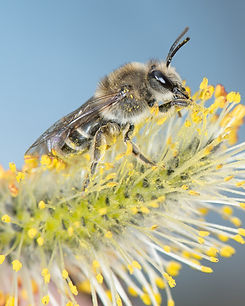
Family Halictidae > Genus Dieunomia
Dieunomia
Large Sweat Bees
In Minnesota, there are two described species within the genus Dieunomia, and both are narrow oligoleges specializing on collecting Helianthus (sunflower) pollen. Dieunomia nest in the ground in sandy sites and often form small to large aggregations of nests. The nests are solitary and very deep (average 105 cm or 40 inches in depth). The species that occur in Minnesota produce one generation per year with the larvae overwintering in a prepupal stage. Males emerge the following summer a few days to a week prior to the females and patrol either the nest aggregation area or nearby Helianthus (sunflowers), searching for females.
Dieunomia are very large sweat bees and range in length from 8 to 19 mm (0.3 to 0.75 inches). Both males and females have a dark gray or black integument and long wings that are smoky or dark (D. heteropoda) or just with dark tips (D. triangulifera). D. triangulifera is very rare in Minnesota and was last collected in 1951. Dieunomia males have a flattened last antennal segment and protrusions on their mid- and hind leg tibia that are used during mating. Females collect pollen on the hind legs and hairs on the underside of the abdomen. Dieunomia can be confused with large Andrena species. However, Dieunomia lack facial foveae and have a V-shaped indentation on the base of their first abdominal segment (T1).

A Dieunomia heteropoda male visiting Helianthus petiolaris.

A pair of Dieunomia heteropoda males asleep in a Helianthus petiolaris flower.

wing
position
on flowers

N0. species in MN
2
size range

Phenology

Genus Characteristics

Males have strongly curved antennae with last antennal segment flattened.

Males with protrusions on mid- and hind tibia and long basitarus.

Males and females with a V-shaped notch at the base of the first abdominal tergite (T1).

Female with thick pollen-collecting hairs on the hind leg tibia and basitarsus.
Dieunomia Species in Minnesota
Scientific Name | Likely Lecty | Host | Sociality |
|---|---|---|---|
Dieunomia heteropoda | oligolectic | Helianthus + (Gibbs 2023 & Arduser) Helianthus petiolaris | solitary |
Dieunomia triangulifera | narrow oligolectic | Helianthus (Arduser) | solitary |
Source: Minnesota Department of Natural Resources, Minnesota Bee Species List (August 2023).
https://files.dnr.state.mn.us/eco/mcbs/mn-statewide-bee-list.pdf

Dieunomia habitat
Explore More Halictidae Genera
Explore Bee Families

Apidae
15 genera, 133 species
Bumble bees Bombus
Longhorn bees
Epimelissodes, Eucera, Melissodes
Carpenter bees
Ceratina, Xylocopa
Honey bees Apis
Digger bees Anthophora
Cuckoo bees Brachymelecta, Epeolus, Holcopasites, Nomada, Neolarra, Triepeolus
Squash bees Xenoglossa

2 genera, 39 species
Halictidae
10 genera, 133 species
Metallic green sweat bees
Agapostemon, Augochlora, Augochlorella, Augochloropsis
Large sweat bees
Dieunomia, Nomia
Short-faced bees Dufourea
Sweat bees Halictus
Small sweat bees Lasioglossum
Cuckoo (blood) bees Sphecodes
Megachilidae
14 genera, 86 species
Resin and pebble bees Anthidiellum, Dianthidium, Heriades, Paranthidium
Carder bees Anthidium, Pseudoanthidium
Mock orange bees Chelostoma
Mason bees Osmia, Hoplitis
Leafcutter bees Megachile
Sharp-tailed cuckoo bees Coelioxys
Dark cuckoo bees Stelis

Citations and Further Reading
Blair, B. H., & Cockerell, T. D. A. (1935). The bees of the group Dieunomia. Journal of the New York Entomological Society, 43(2), 201-215.
Cross, E. A., & Bohart, G. E. (1960). The biology of Nomia (Epinomia) triangulifera with comparative notes on other species of Nomia. University of Kansas Science Bulletin, 41(6), 761.
Droege, S., et al. (2024). The Very Handy Bee Manual: 2.0. How to Catch and Identify Bees and Manage a Collection.
Gibbs, J., Hanuschuk, E., Miller, R., Dubois, M., Martini, M., Robinson, S., ... & Onuferko, T. M. (2023). A checklist of the bees (Hymenoptera: Apoidea) of Manitoba, Canada. The Canadian Entomologist, 155, e3.
Mitchell, T. B. (1960). Bees of the eastern United States. Technical Bulletin No. 141. North Carolina Agricultural Experiment Station.
Portman, Z. M., Gardner, J., Lane, I. G., Gerjets, N., Petersen, J. D., Ascher, J. S., ... & Cariveau, D. P. (2023). A checklist of the bees (Hymenoptera: Apoidea) of Minnesota. Zootaxa, 5304(1), 1-95.
Wilson, J. S., & Messinger Carril, O. J. (2016). The bees in your backyard: a guide to North America's bees. Princeton University Press.
Page Photography Credits
Heather Holm
Ron Goetz CC BY-NC 4.0 (Nomia)
Michelle Orcutt CC BY-NC 4.0 (Dieunomia)















